“Never judge a book by its cover”–an archetypal, popular, and transcultural idiom that propagates the importance of determining an entity’s features not just based on its appearance. However, this is not always the case in art.
In the 1964 work “Against Interpretation”, Susan Sontag expresses her disapproval of overinterpretation in arts, saying interpretation is so stifling that it has become people’s automatic response when observing art, oppressing our world into a narrow sphere of “meanings” (4) and thus, we impoverish art by restricting it only to have one meaning. To lessen the emphasis on interpretation, Sontag proposes that the world needs a more thorough and researched analysis of form (8) that makes art more comprehensible for the audience from the surface without the need to dig deep into the invisible layers of hidden meanings. The existence of Tuồng–a traditional Vietnamese opera art form–is a perfect paradigm for how the appearances of art can play a great role in delivering meanings. In Tuồng, the specially designed make-up, the costumes and props, and the body language of the actors are the art’s quintessential elements due to their vitality in telling the storylines and depicting the context of the plays. The special features of these forefront factors besides the acting and the delivery of songs mark Tuồng from other traditional performing genres and pertaining to its timeless values in Vietnam’s rich treasury of classical art.
How appearances contribute to the value of Tuồng can be analyzed through the make-up and the masks that the characters wear, each portraying the mask wearer’s personality. It can be said that the masks and make-up are the soul and essence of Tuồng because they convey uniquely conventional and symbolic elements for the art form, by which a make-up layout or mask can reflect people’s mentality, personality, and social class, and create a great impression on the audience. The rules for make-up looks in Tuồng were decided based on the social and cultural features of the old Vietnamese society, where people’s perspectives of appearances were imbued with stereotypes and prejudice at the time. Therefore, the makeup not only acts as the characterization of the actors for the audience but also depicts the societal revolution affected by war and colonization of Vietnam. Color is a perspicuous aspect of the makeup looks and masks in Tuồng because of its poignant emotional effect that songs and music cannot echo. Each of the colors is associated with a different personality: Red symbolizes a heroic and loyal person; light green, gray, and off-white colors symbolize evil, despicable, and sinister people; many paint colors mixed and interlaced symbolize demons and monsters. Likewise, the details of the features on the actors’ faces have to be drawn according to a set of rules. For example, characters with thick, even “caterpillar” brows are brave, valiant, and generous heroes. Those with short, sharp brows are deceitful and flattery, and those with slanted red brows are hot-tempered. Because of the intricate details and demand for maximal precision, actors have to learn to do their own makeup to be bold with clear color lines to explicitly portray the character’s personality and increase the expression of the actors’ faces. The extravagant makeup takes the form of Tuồng separates it from other classical art and signifies the art so much more than mere musicality and skills. Thanks to its expressiveness, the audience can grasp a sense of the characters’ personalities more straightforwardly without the need to understand the context or even follow the play, reaffirming Sontag’s opinion that form is as crucial as content.
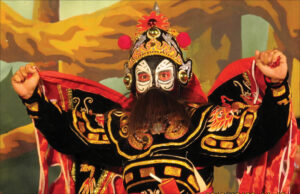
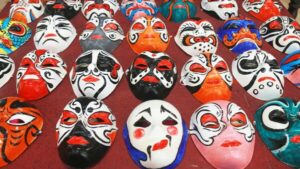
Besides the makeup and masks, the costumes and props of the actors also play a huge role in leading how the audience perceives the play. Costumes for each character are determined according to different positions, regions, personalities, and ages, reflecting the character’s background solely through the fabric’s color and patterns. Clothing is extremely complex in Tuồng due to high standards for historical precision and formulaic representation. The king would wear a crown and shirt that is encrusted or embroidered with dragon images, but depending on which era the play took place in, the king would wear different gowns in different styles imprinted with distinct patterns and colors specific to each dynasty. Civil mandarins wear hats with black round tops, whereas military mandarins wear red or blue crowns. Costumes for actors include all kinds of accessories such as hats (crowns), shirts, armor, scarves, military hats, peasant hats, belts, shoes, etc, each of which has to be worn in a certain and accurate way for the audience to recognize the circumstance of the play successfully. The props that are utilized in Tuồng plays have the same function and level of symbolism. A rattan whip, with a bunch of chopped rattan tied at the tip and at equal intervals, symbolizes the horse. A round plate, two small wooden cups, and a gourd represent utensils for drinking wine. A paddle symbolizes sailing and rowing. Like other symbolic elements in Tuồng theater, costumes and props are figurative and are the most influential factor in reflecting the historical context of each play and scene. The two elements reveal the lives of each class in the country and the social conditions of Vietnam during wartime. Without the care to correctly include these surfacing factors, it would be impossible for Tuồng to be performed and comprehended, or worse, to be classified as a true form of art due to its blasphemy for national history and culture.
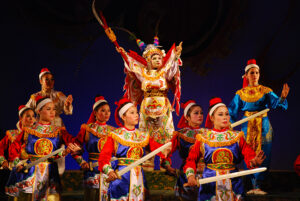
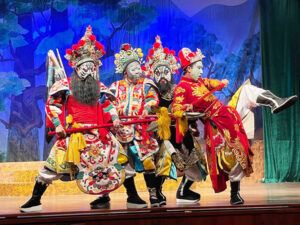
The body language in Tuồng alone can also represent a person’s social background and the context of the play, differentiating the characters’ classes and surroundings between each scene for the audience. Without the need to listen to the lyrics, the audience can understand the space, and time of stage action as well as the characters’ personalities through formulaic movements. Tuồng takes symbolic stylization as the basic artistic criterion. Therefore, not only the costumes, makeup, and stage props but the movements and gestures are exaggerated to become singing, speaking, and dancing with specific principles and rules. Eyes–acting is the top acting principle for Tuồng actors. Performers’ small but expressive gestures of looking, gazing, rolling, glaring, and glancing can establish very discrete emotions, thoughts, and feelings in the audience. For example, the act of looking down symbolizes planning a nefarious plot to solve some problems or pretending to be stupid, goggling symbolizes anger, and staring dreaming eyes at someone else symbolizes love and affection. The rules for hand gestures are also stern and must be done with care and utter precision. The way the actors point their fingers, depending on their roles, will extract different characteristics (gentle, funny, rough, gruff,…). Especially when in dialogue, the subordinate should never point at the superior; servants must not point at their foremen and children must not point at their parents. This rule is built to accentuate the positions and classes of each character and their relationships in the play. The body language in Tuồng is sophisticated with an abundance of trivial details, but it is because of this intricacy that the audience can promptly understand the context and the relationships between the characters on stage. The boisterous and artistically exaggerated movements are what set Tuồng apart from other classical art forms, enhancing the genre’s uniqueness and contributing to how easily watchers can follow the plays.
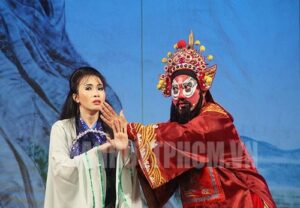
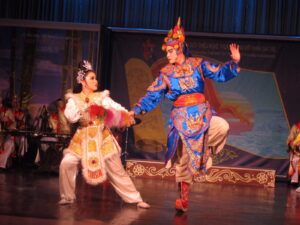
In conclusion, the essence of Tuồng substantially lies in its symbolism through the actors’ appearances and figurative actions. Looking at the makeup of a role, viewers can immediately distinguish between nobles, cowards, loyal servants, flatterers, and traitors; with just a whip, the actors can be seen holding a weapon, riding a horse, or a table sometimes seen as a rock or a king’s throne. The expressiveness of these aforementioned factors allows the audience to extract meanings efficiently without demanding them to dig too much, helping them focus more on the other skill-based values such as acting and singing. Tuồng proves that art should not only be about the content but also the form. Without the elements that bear representative qualities, either it would be impossible for Tuồng to transfer all of its meanings or it would simply not be the extraordinarily aesthetic and unique Tuồng that thousands of Vietnamese generations have enjoyed throughout history. And just like Sontag says: “Transparence is the highest, most liberating value in art–and in criticism–today.” (9), it is the most obvious elements like the appearance of art that strike the most heartfelt experience for the audience when interacting with it. Therefore, though it is right in many cases that we should not judge a book by its cover, when it comes to art, it is important that we assess and extract meanings based on the looks of the artwork. After all, we as humans will always look at something before receiving and processing the information; thus, visual values are always of great importance to how we inspect a certain thing. “We must learn to see more, to hear more, to feel more.” (Sontag, 10).
In order to see the content, we must gaze at the cover.
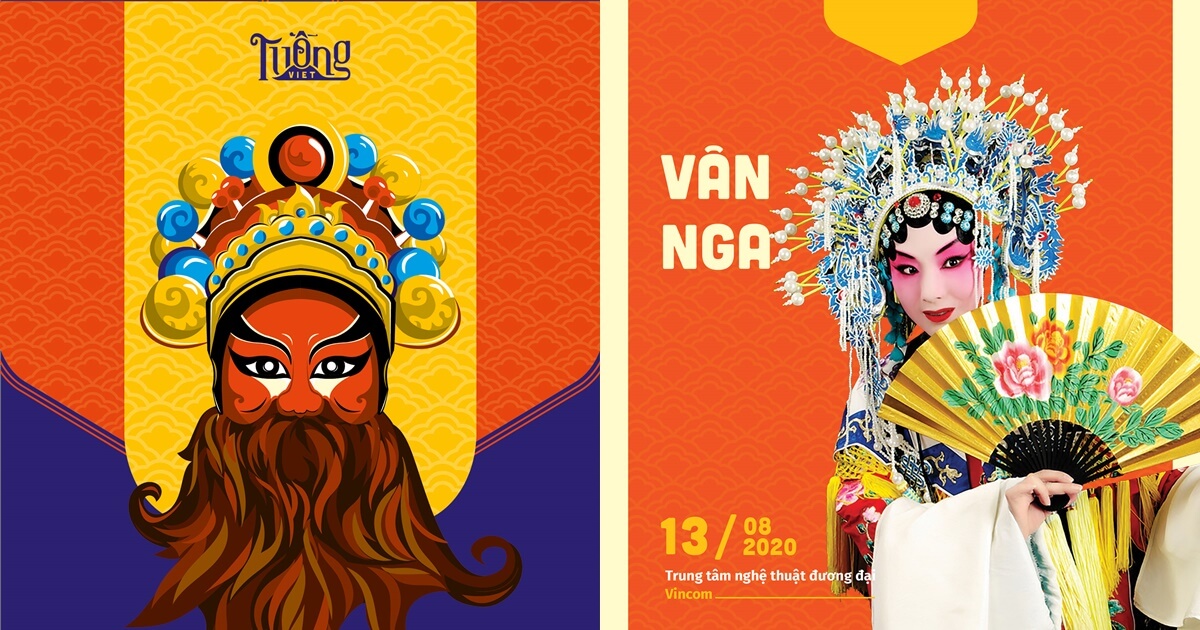
Comments are closed, but trackbacks and pingbacks are open.